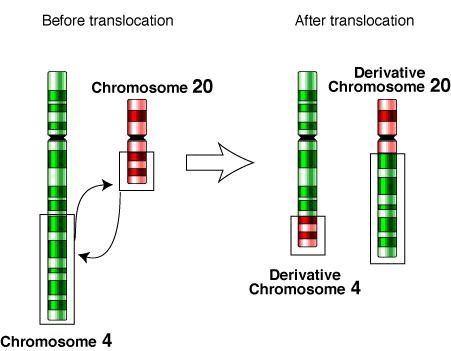 | ||
In genetics, a chromosome translocation is a chromosome abnormality caused by rearrangement of parts between nonhomologous chromosomes. A gene fusion may be created when the translocation joins two otherwise-separated genes, it is detected on cytogenetics or a karyotype of affected cells. Translocations can be balanced (in an even exchange of material with no genetic information extra or missing, and ideally full functionality) or unbalanced (where the exchange of chromosome material is unequal resulting in extra or missing genes).
Contents
Translocations can be reciprocal (balanced or unbalanced) or nonreciprocal (balanced or unbalanced).
Reciprocal translocations
Reciprocal translocations are usually an exchange of material between nonhomologous chromosomes. Estimates of incidence range from about 1 in 500 to 1 in 625 human newborns. Such translocations are usually harmless and may be found through prenatal diagnosis. However, carriers of balanced reciprocal translocations have increased risks of creating gametes with unbalanced chromosome translocations, leading to miscarriages or children with abnormalities. Genetic counseling and genetic testing are often offered to families that may carry a translocation. Most balanced translocation carriers are healthy and do not have any symptoms. But about 6% of them have a range of symptoms that may include autism, intellectual disability, or congenital anomalies. A gene disrupted or disregulated at the breakpoint of the translocation carrier is likely the cause of these symptoms.
It is important to distinguish between chromosomal translocations occurring in gametogenesis, due to errors in meiosis, and translocations that occur in cellular division of somatic cells, due to errors in mitosis. The former results in a chromosomal abnormality featured in all cells of the offspring, as in translocation carriers. Somatic translocations, on the other hand, result in abnormalities featured only in the affected cell line, as in chronic myelogenous leukemia with the Philadelphia chromosome translocation.
Robertsonian translocations
Robertsonian translocation is a type of translocation caused by breaks at or near the centromeres of two acrocentric chromosomes. The reciprocal exchange of parts gives rise to one large metacentric chromosome and one extremely small chromosome that may be lost from the organism with little effect because it contains so few genes. The resulting karyotype in humans leaves only 45 chromosomes, since two chromosomes have fused together. This has no direct effect on the phenotype, since the only genes on the short arms of acrocentrics are common to all of them and are present in variable copy number (nucleolar organiser genes).
Robertsonian translocations have been seen involving all combinations of acrocentric chromosomes. The most common translocation in humans involves chromosomes 13 and 14 and is seen in about 0.97 / 1000 newborns. Carriers of Robertsonian translocations are not associated with any phenotypic abnormalities, but there is a risk of unbalanced gametes that lead to miscarriages or abnormal offspring. For example, carriers of Robertsonian translocations involving chromosome 21 have a higher chance of having a child with Down syndrome. This is known as a 'translocation Downs'. This is due to a mis-segregation (nondisjunction) during gametogenesis. The mother has a higher (10%) risk of transmission than the father (1%). Robertsonian translocations involving chromosome 14 also carry a slight risk of uniparental disomy 14 due to trisomy rescue.
Role in disease
Some human diseases caused by translocations are:
Chromosomal translocations between the sex chromosomes can also result in a number of genetic conditions, such as
Denotation
The International System for Human Cytogenetic Nomenclature (ISCN) is used to denote a translocation between chromosomes. The designation t(A;B)(p1;q2) is used to denote a translocation between chromosome A and chromosome B. The information in the second set of parentheses, when given, gives the precise location within the chromosome for chromosomes A and B respectively—with p indicating the short arm of the chromosome, q indicating the long arm, and the numbers after p or q refers to regions, bands and subbands seen when staining the chromosome with a staining dye. See also the definition of a genetic locus. The translocation is the mechanism that can cause a gene to move from one linkage group to another.
History
In 1938, Karl Sax, at the Harvard University Biological Laboratories, published a paper entitled "Chromosome Aberrations Induced by X-rays," which demonstrated that radiation could induce major genetic changes by affecting chromosomal translocations. The paper is thought to mark the beginning of the field of radiation cytology, and led him to be called "the father of radiation cytology".
